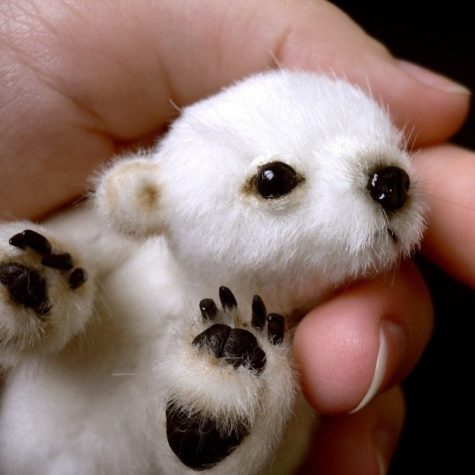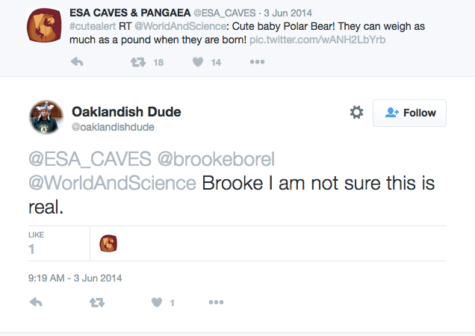Everyone has an embarrassing moment on social media. For me, the most memorable started with an adorable photo of a baby polar bear. The bear had gleaming white fur, big brown eyes, and a sweet expression. It floated into my line of vision one morning two summers ago, as I consumed Twitter while consuming my morning cup of tea.
#cutealert RT @WorldAndScience: Cute baby Polar Bear! They can weigh as much as a pound when they are born! http://t.co/wANH2LbYrb
— ESA CAVES & PANGAEA (@ESA_CAVES) June 3, 2014
Here’s what it looked like:
 #cutealert indeed! I thought. Retweet!
#cutealert indeed! I thought. Retweet!
Pleased with myself for sharing such a lovely image with my followers, I settled back with my tea. But not long after, I received this note:
Then I noticed this:
@WorldAndScience these are real baby polar bears. pic.twitter.com/SDe7Axz2Nk
— Isopod Jones (@gluino78) June 3, 2014
And I thought to myself: Well, of course that’s what a baby polar bear looks like. Mammals come out a little pink and slimy and puffy, not fully formed with gleaming fur and big brown eyes.
So I said this, which frankly doesn’t adequately express the depth of my embarrassment:
I'm afraid you might be right. Whoops! RT @oaklandishdude: @ESA_CAVES @brookeborel @WorldAndScience Brooke I am not sure this is real.
— Brooke Borel (@brookeborel) June 3, 2014
Why I hedged with “might,” I still don’t know. Whoops!
So here’s my confession: sometimes I have a twitchy Twitter finger. My condition has improved over the years—and in particular following The Polar Bear Incident—but it still puts me in the occasional awkward position when I Tweet first and ask questions later.
We’ve all been there, right? Reacting to the flood of our newsfeeds across social media by liking and commenting and sharing and retweeting and regramming and and and? Consume, share, consume, share. Repeat.
But here’s the embarrassing thing: I am the author of the new book The Chicago Guide to Fact-Checking. The book is part guide, part media review and criticism, part philosophical examination of truth and fact. It’s intended mainly for journalists, journalism students, freelancers, newsrooms, and anyone else who is interested in learning the process of fact-checking. In it, I take that process—usually taught apprenticeship-style to interns and early career reporters who happen to land at glossy magazines—out of those newsrooms and into your hands.
Here’s another confession: I was working on the proposal for this book as I was retweeting the fake photo of the baby polar bear.
The moral? I’m not immune to the lure of social media. None of us are if you catch us in just the right moment. And our collective twitchy fingers are a problem, especially if they’re spreading untruths, hoaxes, and other false stories. Even more so considering the current political climate in a particularly soul-sucking election year.
This is true even for people who aren’t journalists or writers or otherwise producing words to inform the public. If you are on social media you are a publisher, even if you don’t think of yourself that way. Every time you like, comment, retweet, share, or otherwise interact with a piece with your twitchy finger, you are effectively republishing it. With each click, you simultaneously broaden a story’s audience and give it your implicit stamp of approval.
We can do better! Me included. Don’t make the mistake I made with the polar bear. Instead, try the Polar Bear Test. Before you share, ask yourself: Is it really a polar bear? Are you sure? Why are you sure? Is that really a good reason to be sure? If not, step away from the computer.
Even if it’s a #cutealert.
__________
Brooke Borel is an independent science journalist and author. She’s a contributing editor at Popular Science and has also written for BuzzFeed News, the Guardian, the Atlantic, Undark, PBS’s Nova Next, Quartz, Aeon, and Slate, among others. She also occasionally drops in at the Last Word On Nothing and Science Friday. Borel is the 2016 Cissy Patterson fellow at the Alicia Patterson Foundation, where she has been writing about pesticides and agriculture. Her books are Infested: How the Bed Bug Infiltrated Our Bedrooms and Took Over the World, published by the University of Chicago Press with additional support from the Alfred P. Sloan Foundation, and The Chicago Guide to Fact-Checking.
_________
Photo: on Buzzfeed via Etsy

Generalization of a skill (like fact-checking) across situations is harder than learning it in one situation. Even after generalizing to some extent, the skill can still “disappear” on one context while still solidly in place in another. Hence–while thinking hard about a book on fact-checking, it’s easy to fail to fact-check when thinking (not hard) about something else.
Fact-checking in social media is particularly difficult because the activity–though in one sense publishing–has much in common with social stroking, which does not demand fact-checking (and fact-checking would inhibit it.) Re-tweeting may have a social purpose that is at odds with fact-checking (I have re-tweeted things I didn’t agree with–or fact-check–because I thought they were interesting and some of my followers might want to see them.) Social media is often like a group of acquaintances wandering through another city, saying “Hey–look at that! That’s the coolest balcony design!” and then (in another venue or the same one) commenting on what they looked at in terms of their own reaction, w/o reference to whether the thing seen was an expression of truth. (“Yeah, but you haven’t seen the balconies in Barcelona! Those balconies are the coolest ever.”) And at other times the same people may be fact-focused, fully critical and aware that they’re sharing information with others. “Here’s the link for the opening session of the International Whatsit of Whoosits conference.”
I doubt that fact-checking will ever be universal on social media. People will continue to share pictures they haven’t investigated, statements they haven’t fact-checked, just as they do in casual conversation, because that’s what social media is…one vast public square with little cafes around the edge, and only some of them will go find out that the statue in the square isn’t really a product of ancient Rome or medieval Burgundy, but instead an attempt at a historical form by an early 20th century artist before they point to it and say (to everyone) “Wow, look at that–it’s gotta be Roman, guy in a toga (or, “medieval knight in armor on a horse.)”
True, misinformation can go global faster now. And it would be nice if it didn’t. But while still clinging to the structure of fact-finding and fact-checking, I think lots of cats are already out of lots of bags and we’re just going to have to deal with that. I could of course be wrong.
Point taken & well made. (Otoh, still a cute pic. 🙂